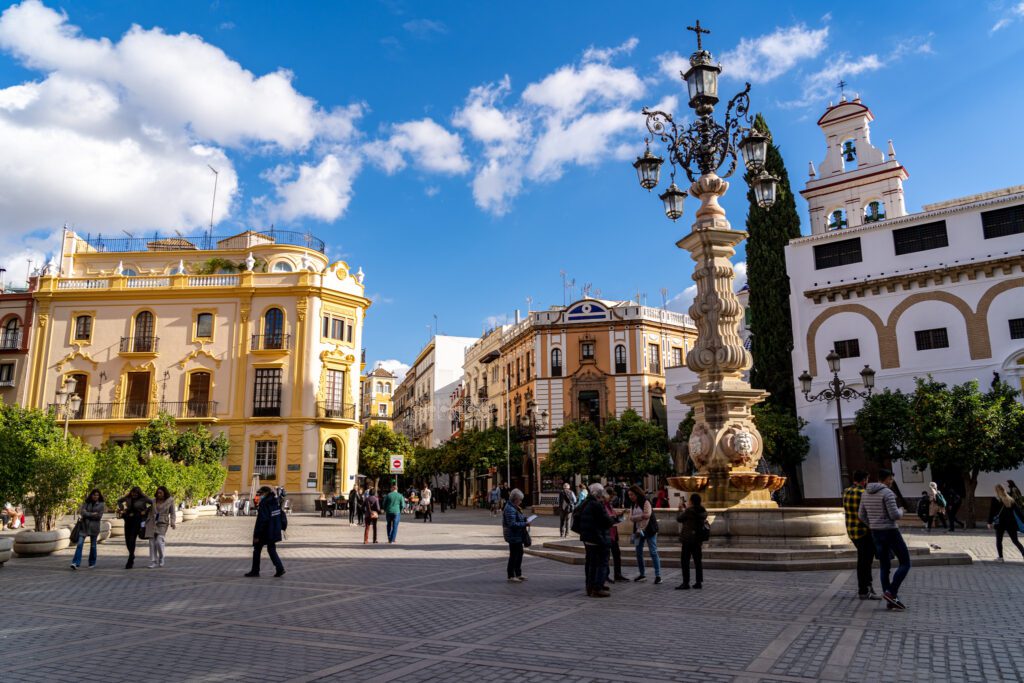2 Days in Seville: How to Plan an Amazing Seville Itinerary
Looking for a warm and sunny place to spend a couple of days in southwestern Spain that is full of history and culture? We’ve got you covered with this guide to spending 2 days in Seville. We spent four days in the city and fell in love with its charm and atmosphere, which is a little bit of a cross between Amsterdam and a smaller (but equally charming) city like Verona.
Seville – the capital of Andalusia – is a lovely city in southwestern Spain, straddling a picturesque river that was an important link to Spain’s colonies in the Americas and led to the rise of the city as a regional powerhouse.
The weather is warm (sometimes too warm if you’re visiting Seville in the summer), the people are friendly, and there’s a ton of history to learn about that applies to both Seville as a city and the Spanish empire as a whole.
On a tour in Madrid, our guide mentioned that Seville is the most “Spanish” city of the major cities in Spain. Dinner is late, Flamenco is big, and tapas rule the dining scene.
However, after our visit, we began to realize that it’s incredibly difficult to separate “Spanish” culture from the influences of the Muslim kingdoms that presided over Andalucía for centuries before the alignment of the historical kingdoms of Spain.
Everything from the food to the architecture and even the language has at least some roots in the Muslim world.
Seville is full of places indicative of the collision between the two cultures – teterías (tea rooms) serving tea and hookah, the cathedral built over the site of a mosque (and keeping many of the mosque’s elements), and a royal palace decorated almost entirely in an Islamic style by a Christian king are just a few.
The result of that collision is a vibrant, beautiful city that reflects its history and entices you to learn more about it.
Over the course of this Seville itinerary, you’ll do just that. We’ve written it for 2 days, which we think is the right amount of time to see the highlights of the city, but have ideas below the main itinerary on how to compress it into one day, and how to extend it into three or more days.
P.S.: Planning a trip to Spain? We have a detailed Spain itinerary plus guides to Barcelona, Madrid, and Granada to help you plan an amazing trip!
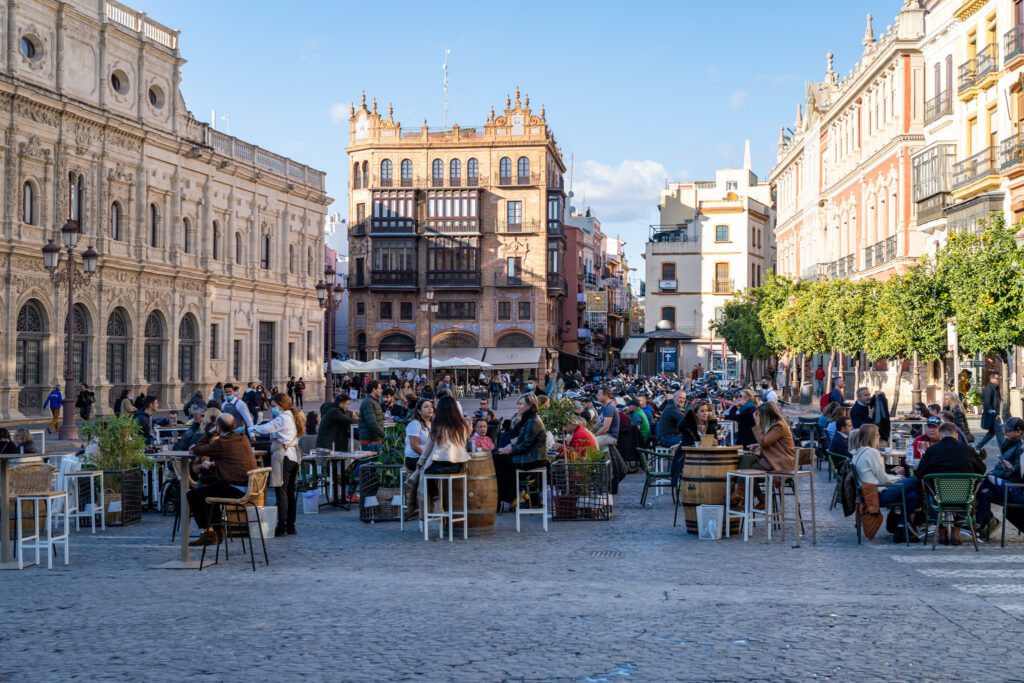
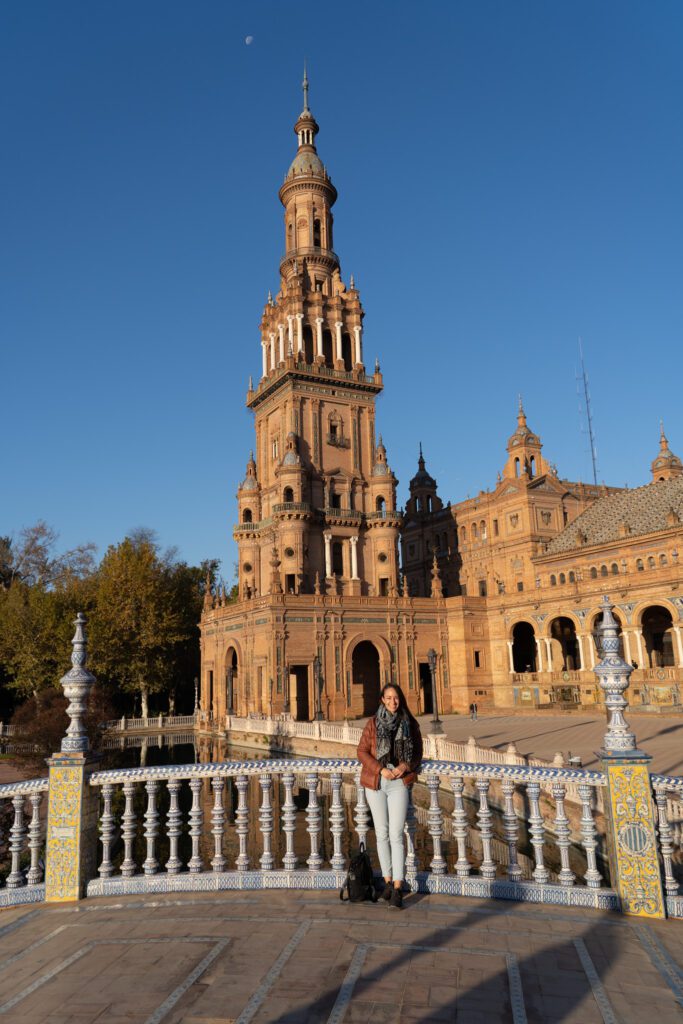
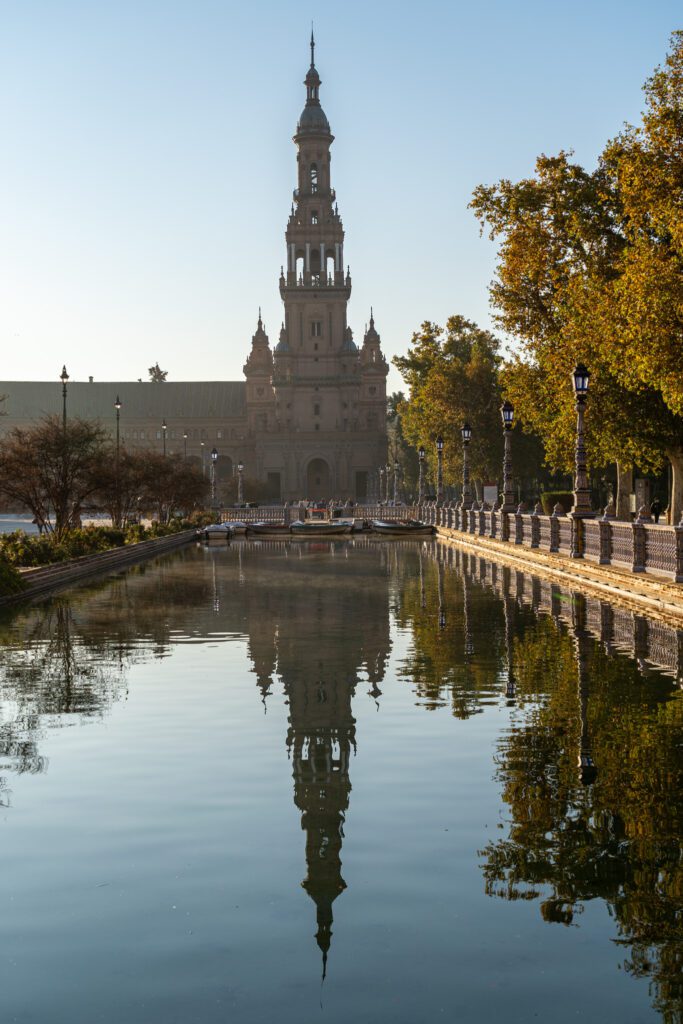
Disclaimer: Some of the links in this post, like hotel links, are affiliate links, meaning at no additional cost to you, we make a little bit of money if you click through and book. That being said, we would never recommend something to you that we don’t stand behind 100%.
Is 2 Days in Seville Enough Time?
We think that two days is a good amount of time to spend in Seville itself.
You can split up the two major sites – the Alcázar and the Cathedral – to do them on separate days, and fill in the rest of your time with good views, food, and drinks.
With 3 days in Seville, you have two choices. Either you can spend an extra day in the city and have a more relaxed itinerary, or you can take a day trip to Córdoba, which is a 40 minute train ride away, to see the Mosque-Cathedral.
We’d recommend the day trip, because we really enjoyed Córdoba.
Where to Stay in Seville
With just a couple of days in Seville, we’d recommend staying as central as possible. In this case, that really means you should do your best to stay in Seville’s historic center.
There are two neighborhoods in particular that we’d recommend, and both offer a slightly different experience.
They are Barrio Santa Cruz, the charming former Jewish Quarter, and Centro, the more commercial area where streets are lined with shops of all kinds.
Barrio Santa Cruz
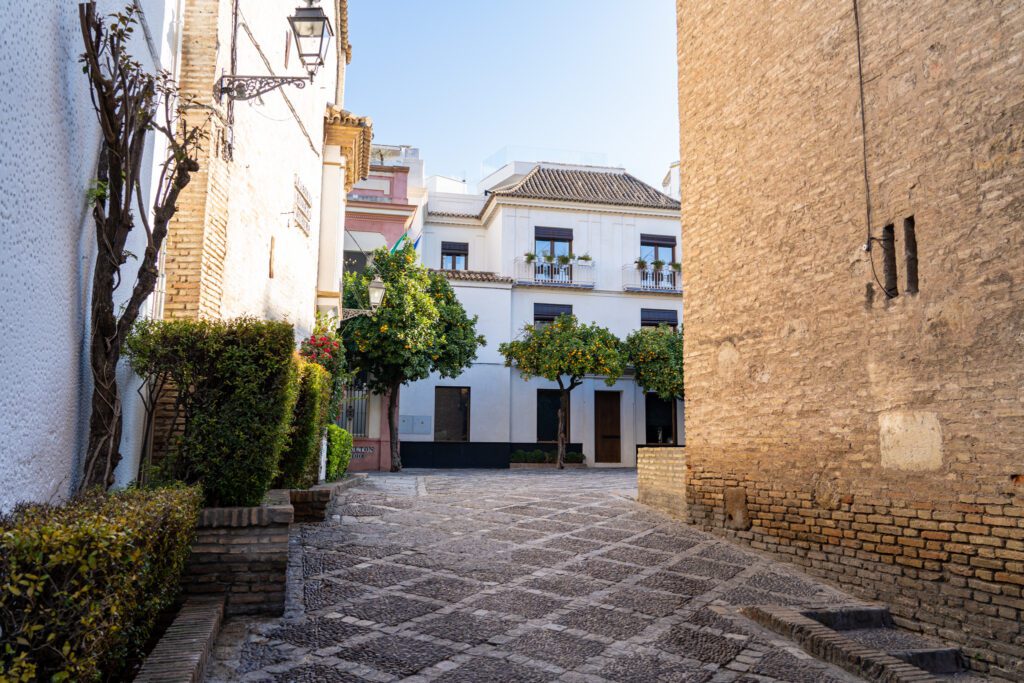
Barrio Santa Cruz, the old Jewish Quarter, is adjacent to the Cathedral and Alcázar, and is extremely charming with its narrow, cobblestone streets.
It’s a great location, charming atmosphere, and for the privilege, you’re going to pay a little extra.
Centro
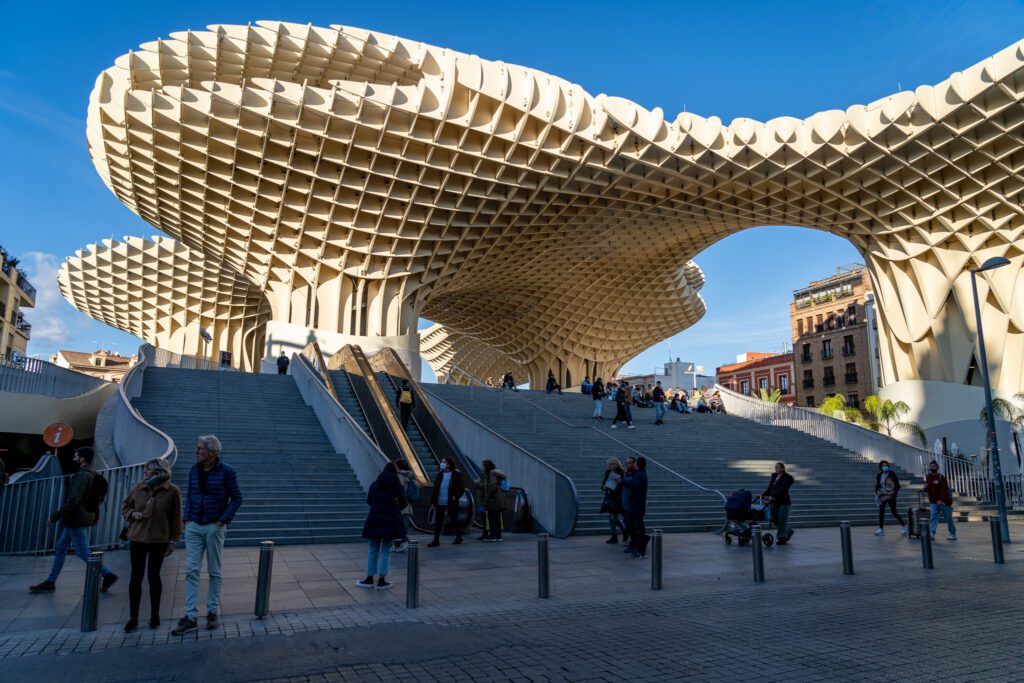
Centro, which we’re calling the area centered around the Setas de Sevilla, is more utilitarian than charming.
It’s about as central as it gets – as you might have guessed based on the name – but it’s less charming than, say, Santa Cruz.
Instead of narrow cobblestone streets, it’s more shop-lined pedestrian corridors packed with people shopping their hearts out.
For what it’s worth, we stayed here (at the excellent apartments at Come to Sevilla Casa de las Especias), and found it to be a nice home base for exploring Seville.
2 Days in Seville: A Complete Guide to Planning Your 2 Day Seville Itinerary
Over the course of a couple of days in Seville, you’ll get to learn about the city’s fascinating history, take in a couple of downright amazing views, and dive into the food culture.
Here’s an overview of the detailed itinerary you’re going to find below.
- Day 1: Good coffee, the Royal Alcázar, the Triana neighborhood, and churros con chocolate
- Day 2: The Seville Cathedral, Plaza de España, Las Setas de Sevilla, and choose-your-own-foodie-adventure
Now, let’s get into exactly how to plan an amazing Seville itinerary!
Day 1: The Alcázar, the River, and Churros
On your first day in Seville, spend the bulk of your time on the Royal Alcázar, which along with the Alhambra in Granada and the Mosque-Cathedral in Córdoba, forms a triumvirate of exquisite pieces of Islamic architecture in Andalucía (though you’ll learn why that statement is only partially correct at the Alcázar).
But First, Coffee
Before heading out for a major history lesson, you’ll want to be nice and caffeinated. At least I like to be, anyway. If you’re not into coffee, skip this section and head straight to the Alcázar. If you, too, are a full-blown caffeine addict, let’s talk coffee!
There are several great places to get coffee in Seville’s center, but there are two that really stand out to me.
The first is Delatribu, which is in the Santa Cruz neighborhood – Seville’s former Jewish Quarter – and is literally two minutes from the entrance to the Alcázar. In other words, it’s the perfect stop for a quick pick-me-up before your visit.
They have espresso-based drinks like cappuccinos and lattes if you prefer your coffee with milk, and they also have filter coffee made with an Aeropress or V60. I was very impressed with the barista’s Aeropress skills, which are far better than my own, and liked the coffee so much I bought a bag for myself.
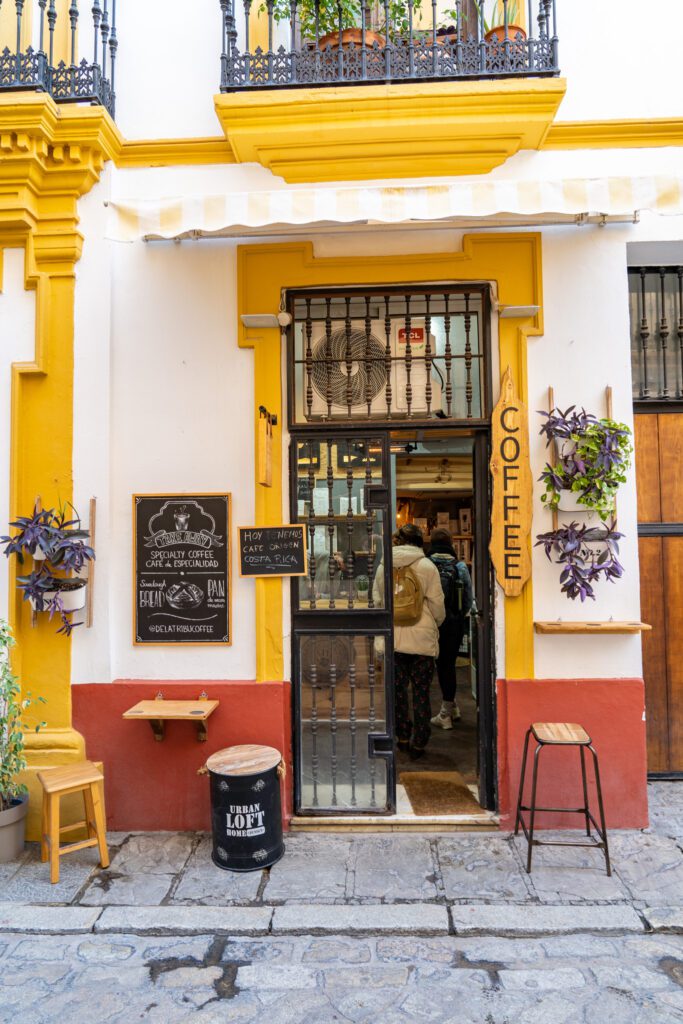
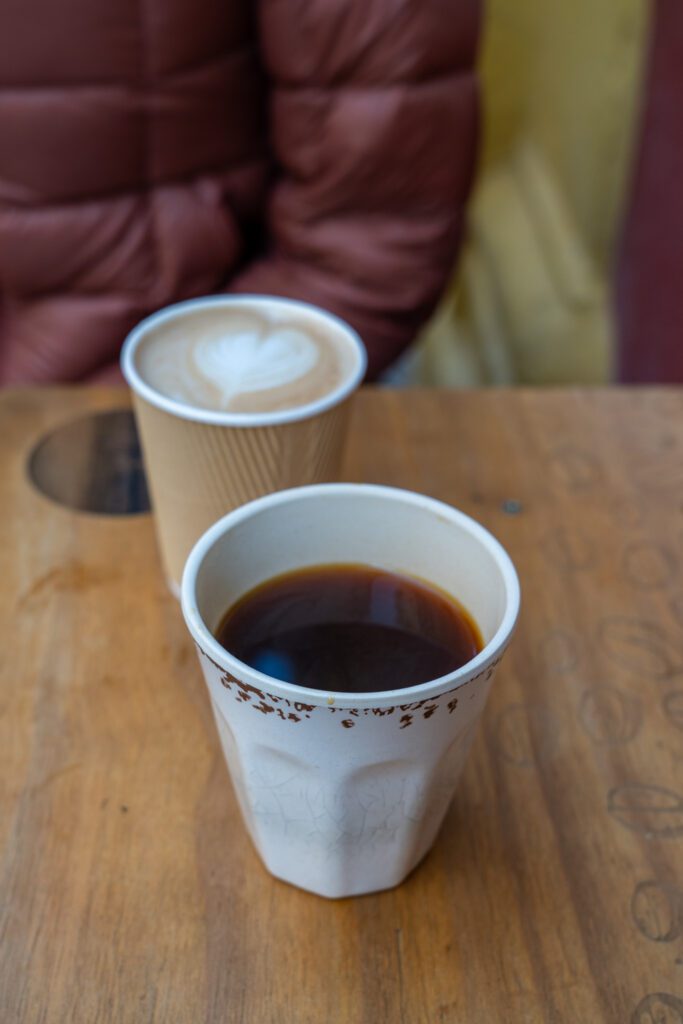
The second is Virgen Coffee, which is just north of the Setas de Sevilla and would make a good stop if you’re coming from the Centro area. It’s a tiny little coffee window – no seating here – but the coffee is good, and they roast it themselves.
Royal Alcázar of Seville
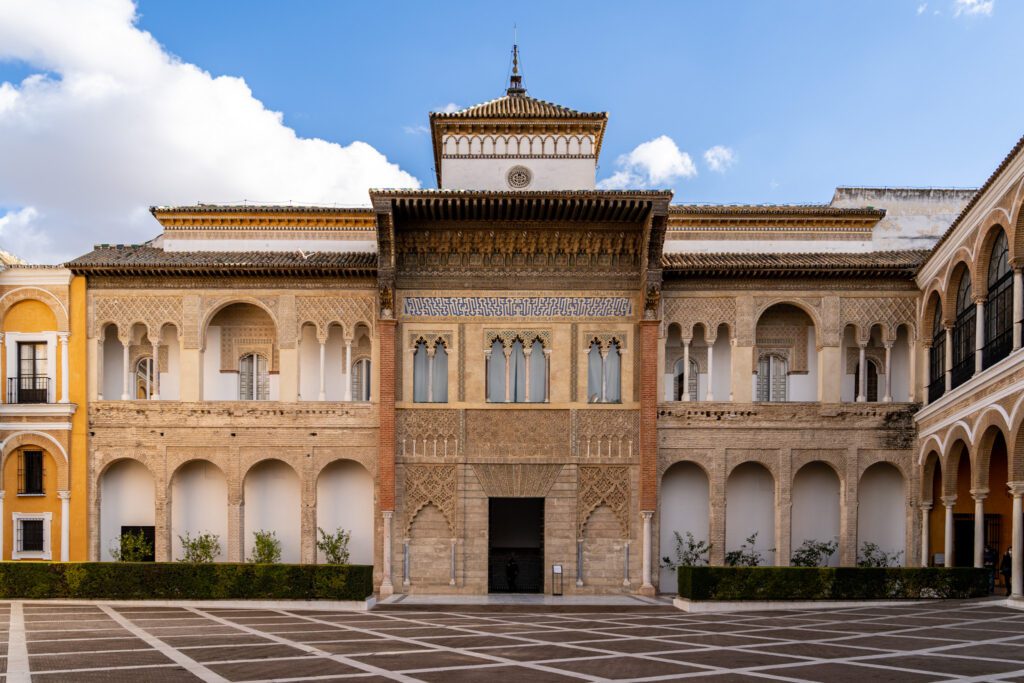
The Royal Alcázar of Seville is perhaps the best introduction to the history of Seville, because its construction and subsequent updates over the centuries involves many of the main cast of characters in Seville’s history.
An Alcázar is a structure with two purposes – half defensive structure, half palace. From the outside, it looks like a fortress with its imposing walls and gates, but once you’re inside, it’s much more opulent.
This has to do with the history of the building, which was originally built by the first Caliph of Andalucía (on the site of a former Visigothic basilica, which adds to the layers of history here).
It was expanded over the several centuries when the caliphate was in control of Sevilla, but it looked nothing like it does today. It was much smaller and more modest.
That is, until the Castillans showed up in 1248, and King Ferdinand III took the city for what would become the Spanish kingdom.
From that point, the palace was continually expanded and improved over the centuries as each new royal came into power and wanted to put their own decorations up (essentially).
At one point, King Charles V decided he wanted a whole second story added. And, well, he’s the king (emperor of the Holy Roman Empire, too!), so what he says goes, I guess.
The most interesting expansion, at least in our eyes, is the Mudéjar palace that was built by King Pedro I in the 14th Century.
It’s the part of the complex that you should spend the most time on because it’s the most emblematic of the different styles and influences present in Seville during that time period.
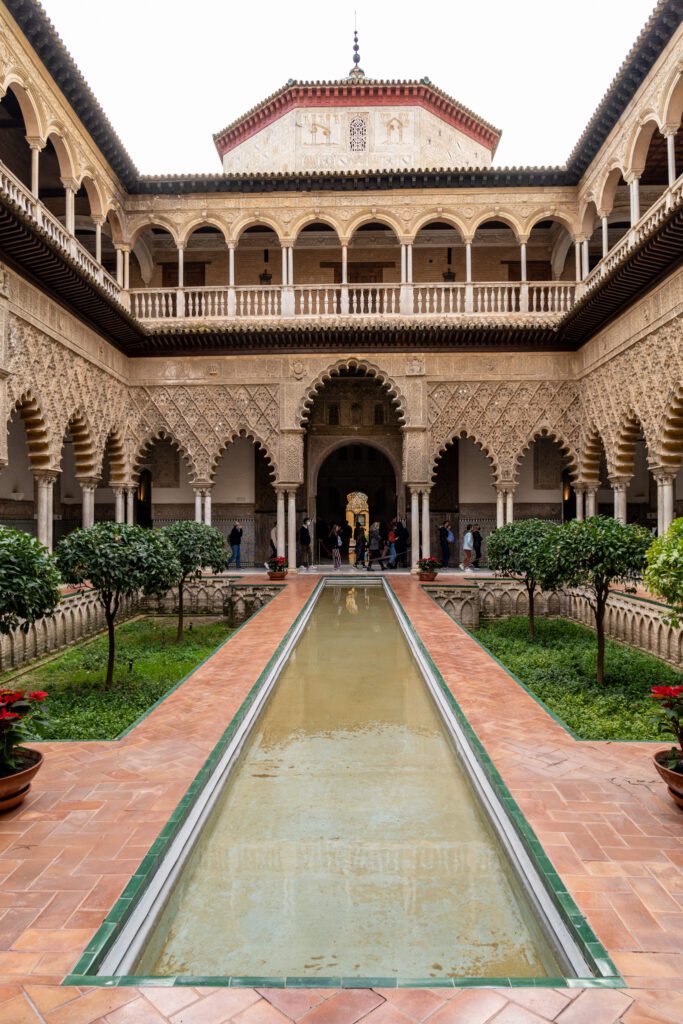
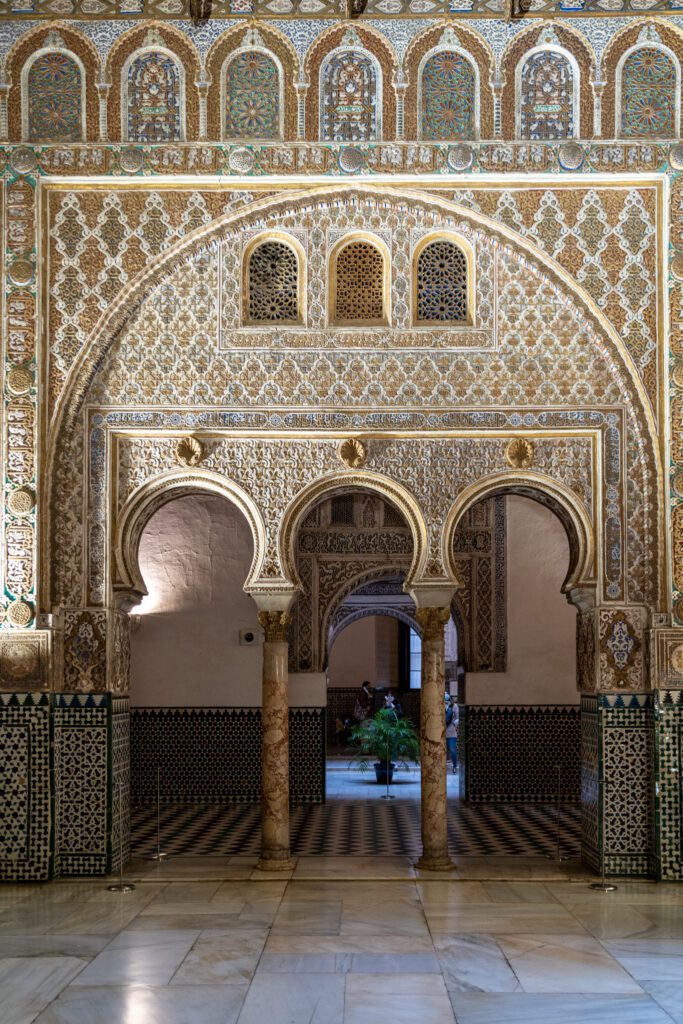
For reference, the term Mudéjar refers to a specific architectural style that you’ll find in the southern parts of Spain and Portugal.
It had its heyday in the 13th – 16th Centuries, and is the movement that introduced Islamic elements like intricate plaster designs, horseshoe arches, and beautiful tilework similar to what you’ll find at the Alhambra in Granada to the now-Christian kingdoms on the Iberian Peninsula.
However, unlike the Alhambra, which was a palace for a Muslim ruler, this palace was built for a Christian king, which we think is fascinating.
Especially when you consider that the two kingdoms had recently been at war.
If you’re not quite convinced that you should spend some time in that particular palace, Game of Thrones chose this palace as a filming location in Season 5 for the scenes in Dorne.
If it’s good enough for Game of Thrones (pre Season 8, at least), it’s good enough for us.
There are three other main parts of the complex that are worth visiting:
- The Casa de Contratación – where everything related to trade and the Americas was done until the 18th Century.
- The Gothic Palace – which has some incredible tapestries, including a cool map or the Spanish Empire.
- The Gardens – which have one of the two water organs in operation in Europe (it plays every hour, on the hour).
One last thing to know – the complex still technically serves its function as a royal palace to this day, it’s just that the royals don’t make it to Seville very often, and when they do they usually stay at a luxury hotel in the city instead.
How to Visit the Royal Alcázar of Seville
Throughout the palace – including over the front door – you’ll find Arabic script referencing Allah alongside Christian elements like shields with a coat of arms.
It’s one big mishmash of different architectural elements, partially because of the Mudéjar style, and partially because it was tweaked by countless royals over the several centuries since it was built.
For that reason, we’d highly, highly recommend a guided tour so that you can truly understand what you’re seeing.
At first glance, it looks similar to the Nasrid Palaces at the Alhambra, but diving a level deeper you’ll start to understand that it’s actually very different, and it’s an interesting look into the history of Seville (and Spain as a whole, really).
We did this tour with José, and at the end Alysha turned to him and remarked that we never, ever would have noticed half of the details he pointed out and explained over the course of the two hours we spent working our way through the palace complex.
Click here to check prices, reviews, and availability for José’s tour.
If you want to visit the palaces independently, you definitely need to buy tickets in advance. You can get them on the official website. Tickets cost 13.50 Euros for adults, and reduced tickets are 6 Euros.
The complex is open 9:30 am to 6:00 pm (last entry at 5:00 pm) from October 29 to March 31, and from 9:30 am to 8:00 pm (last entry at 7:00 pm) from April 1 to October 28.
These things change, so check the official website for up-to-date information.
The River Loop & Mercado Triana
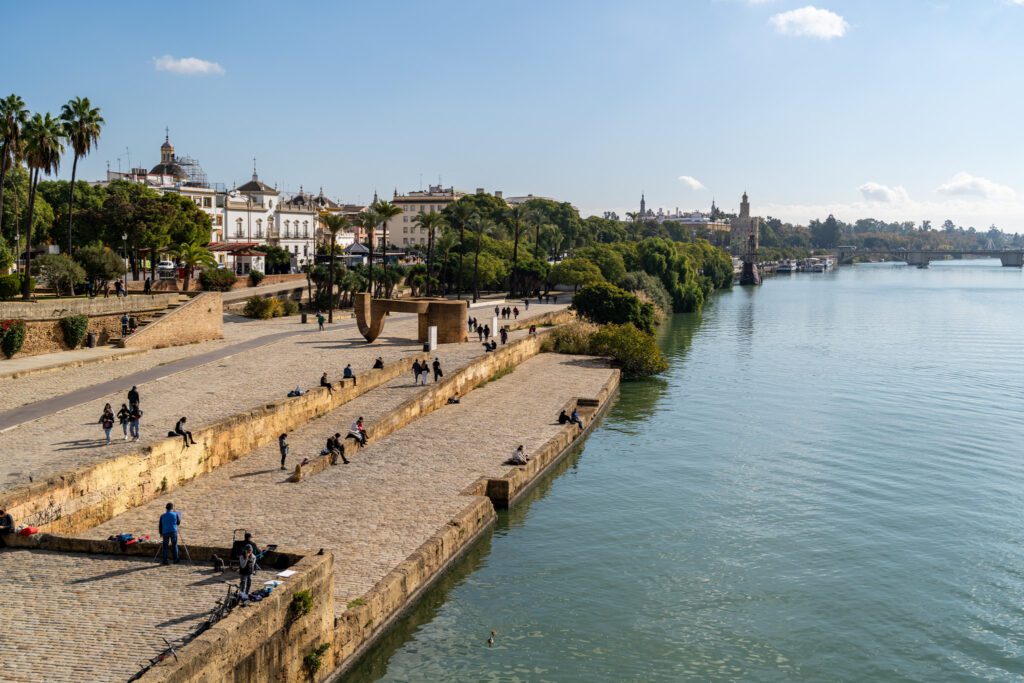
The Guadalquivir River, which runs through the center of Seville, plays an important role in the city’s history.
It connects the city to the ocean, which made it the connection point between the Spanish Empire’s holdings in the Americas and the Spanish mainland.
That is, until the boats became large enough that the river could no longer accommodate them, and the connection point moved closer to the coast in Cádiz.
We really enjoyed a walk along both sides of the river. Start from the Torre del Oro, which is a former defensive tower along the river that has been turned into the naval museum.
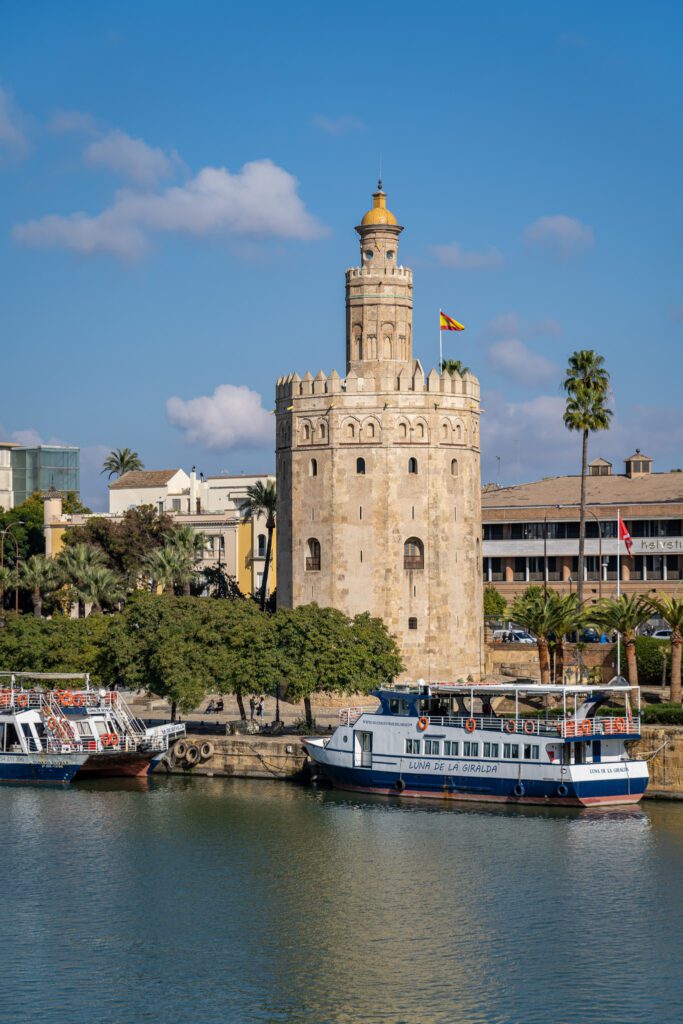
A note here: We had read in multiple places that the museum was okay, but the view from the top was worth the price of admission. We think the people – and there were multiple – who wrote some version of that had never actually done it.
The museum is tiny, but kind of cool if you’re into naval history.
The view from the top is average at best, and we’d save your money to do either the Giralda at the Seville Cathedral or to go to the top of the Setas, the giant wooden structure in the middle of the city.
Both are significantly better views all around.
Admire the Torre del Oro from the outside, and head north along the eastern bank of the river. Follow the river north to the Puente de Triana – the bridge that crosses over into the more residential Triana neighborhood.
As soon as you cross the bridge, you’ll find the best market in Seville’s center, the Mercado Triana.
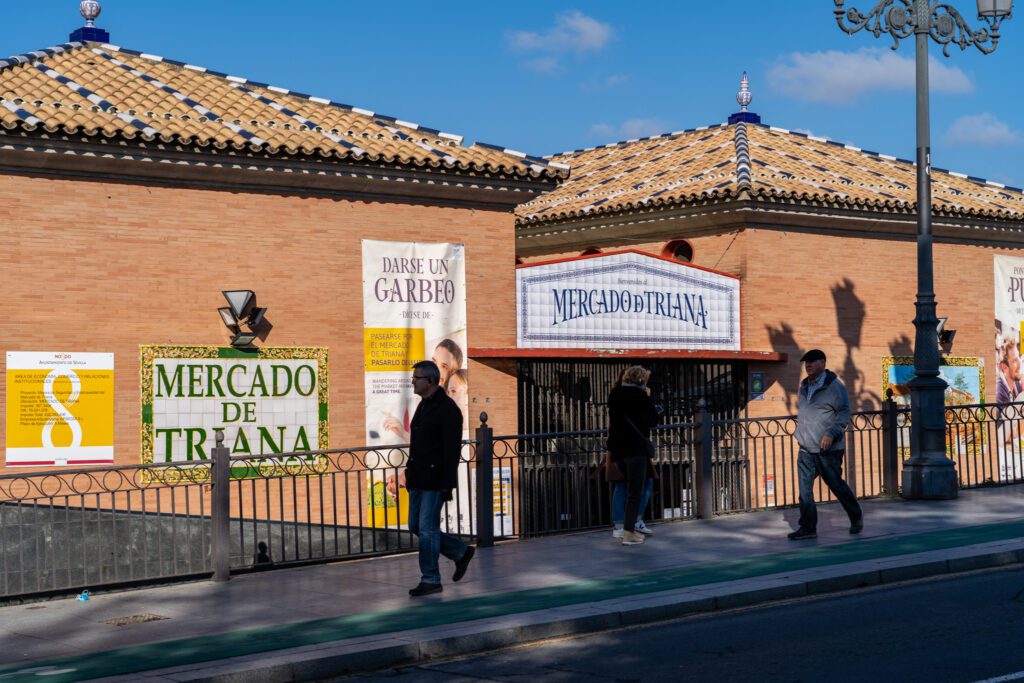
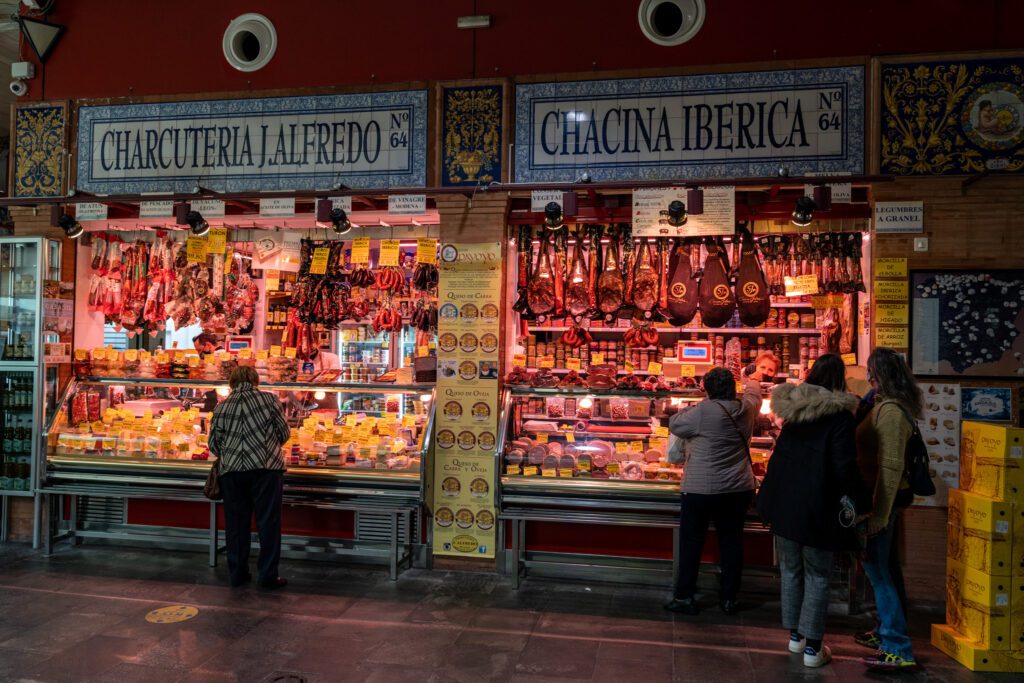
It’s part produce, meat, and cheese market, part place to get some prepared food for lunch or a snack. There’s even a cooking school inside the market which focuses on both international and Spanish cuisine.
If you’re interested in going deeper on the market, the cooking school does a guided market tour where you’ll visit with a local guide and taste your way through the market.
Meander back through the Triana neighborhood to the Puente de San Telmo, and cross back over the river to the point where you started.
Vermut and Churros
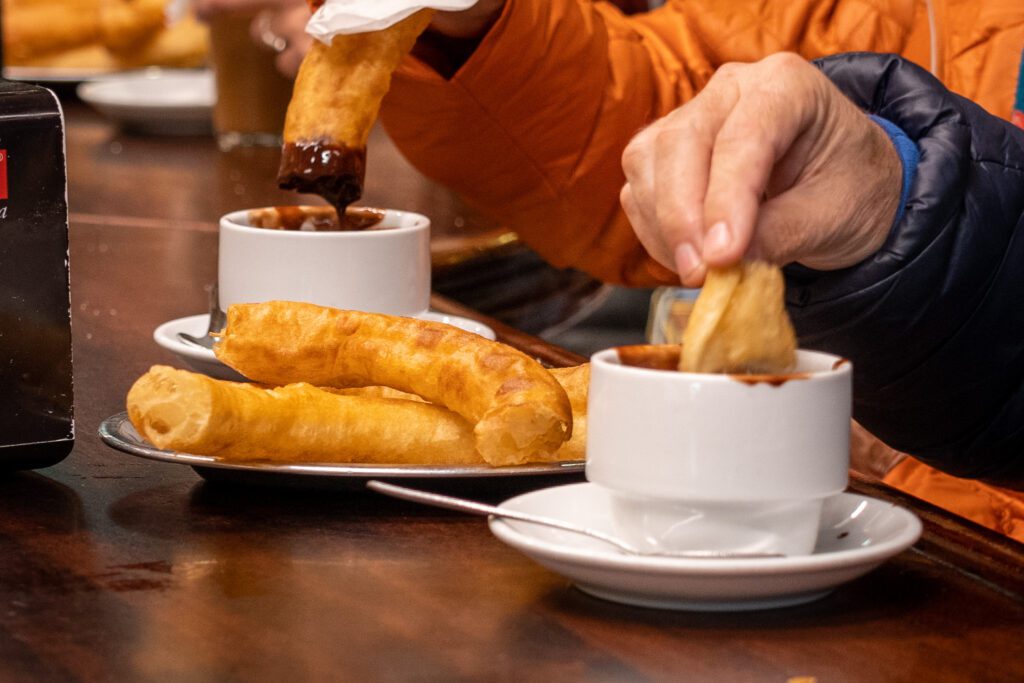
For a pre-dinner snack, head over to the central district for a taste of churros con chocolate at one of the oldest bars in the entire city.
The bar we’re talking about is Bar El Comercio, and we walked by it about four times at all different hours of the day before stopping in, and every single time it was packed full.
They claim to be THE oldest bar in the city, operating since 1904, but I’m always skeptical of claims like that. Still, it’s clearly popular with locals (and tourists, of course) given that it was packed with Spaniards at all hours.
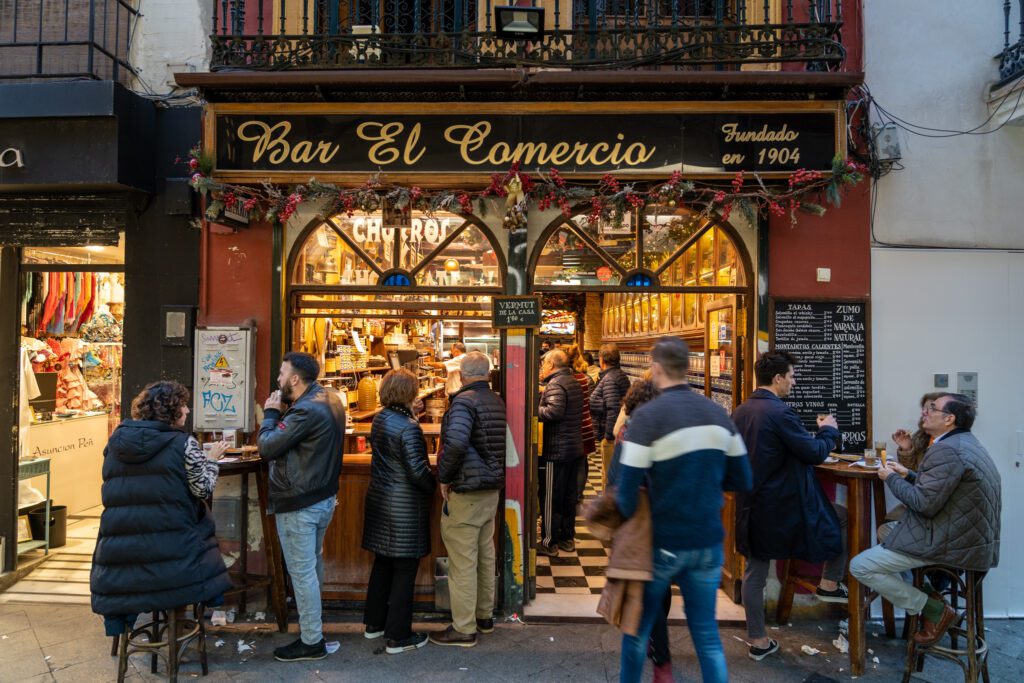
The highlight here is going to be the churros, which are not coated in sugar like they are back home (or in Mexico City), which means they’re decidedly less sweet. Order them “con chocolate”, and you’ll get a cup of hot, thick chocolate to dip them in.
They’re really meant to be a breakfast food – which is wild to us coming from the United States – but they’re just as delicious in the afternoon, and we saw plenty of people eating them at around 6:00 pm when we were there.
Sadly, I have Celiac Disease and need to eat gluten free, so no churros for me. But lucky for us, the other two things to try here are both alcohol AND gluten free.
First, they are known for their vermut, which you might know as vermouth depending on where you’re from.
We learned in Barcelona that Spanish vermouth is much, much different than the vermouth we’re used to, which primarily comes from Italy and France.
Spanish vermouth is sweeter, more complex, and more herbaceous (medicinal is also a word we’ve used to describe it).
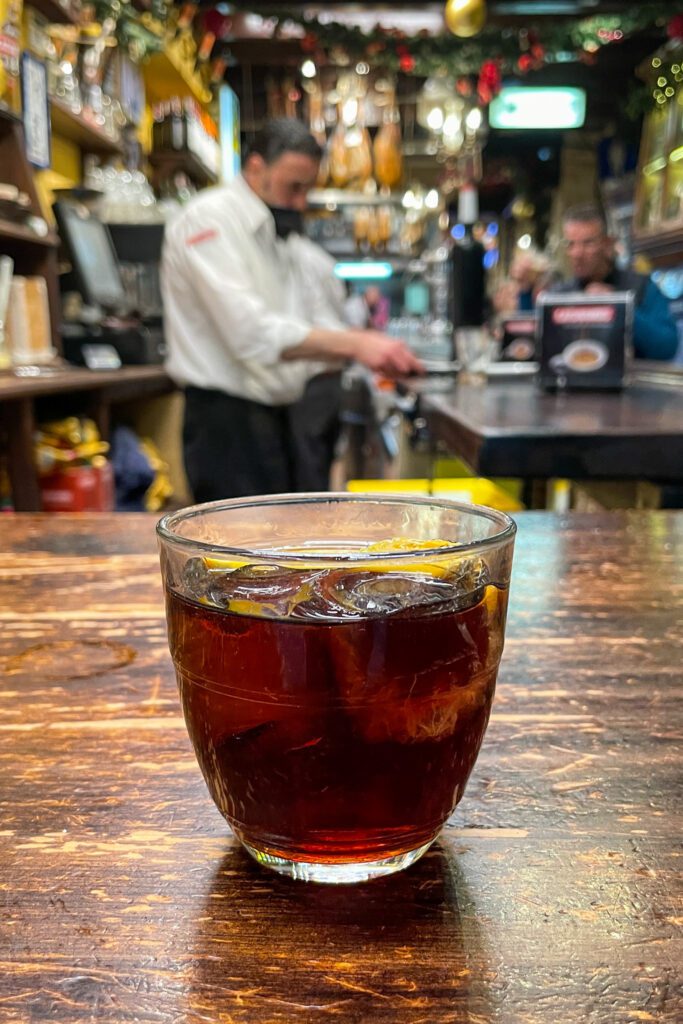
The second thing you should try is the vino de naranja, which is NOT the same kind of “orange wine” you’re thinking of if you’re into natural wine.
It comes from Huelva, which is close to the Portuguese border, and they put those bitter oranges that you’ll see all over Sevilla (and the rest of Andalucía ) to good use – by making alcohol with them!
It’s a type of wine that you’ll only find in southern Spain that is aged with macerated orange peels to give it a dark color that looks almost like a whiskey. And it’s pretty delicious.
Here’s a good primer on vino de naranja to read to learn a little more before your trip. They also have a great guide to chocolate con churros, which I also enjoyed reading despite knowing I would not be getting to indulge myself.
The best place to try vino de naranja in Seville is at Taberna Álvaro Peregil (also known as La Goleta, we think?), which is where we first tried it, but you can get it at Bar de Comercio too.
Dinner and Drinks at Alameda de Hércules
We stumbled upon Alameda de Hércules on a meander through the Macarena neighborhood, and we were immediately enamored with the wide, open plaza set between two tree-lined streets.
It reminded us a lot of La Condesa in Mexico City, which is one of our favorite neighborhoods in the entire world.
This is the place to go for dinner and drinks.
Speaking of Mexico City, at this point in our trip to Europe, we had gone almost three months without eating a single taco (or any Mexican food). Which is a problem for us. Mexican food is our favorite.
We really enjoyed Mano de Santo, a Mexican restaurant (that is 100% gluten free, might I add, but this is their only dedicated gluten free location) with good food and great drinks.
It’s at the south end of the plaza, and they have a nice, shaded outdoor patio. Get the tostadas, which were our favorite thing we ate there, and the deconstructed tres leches cake.
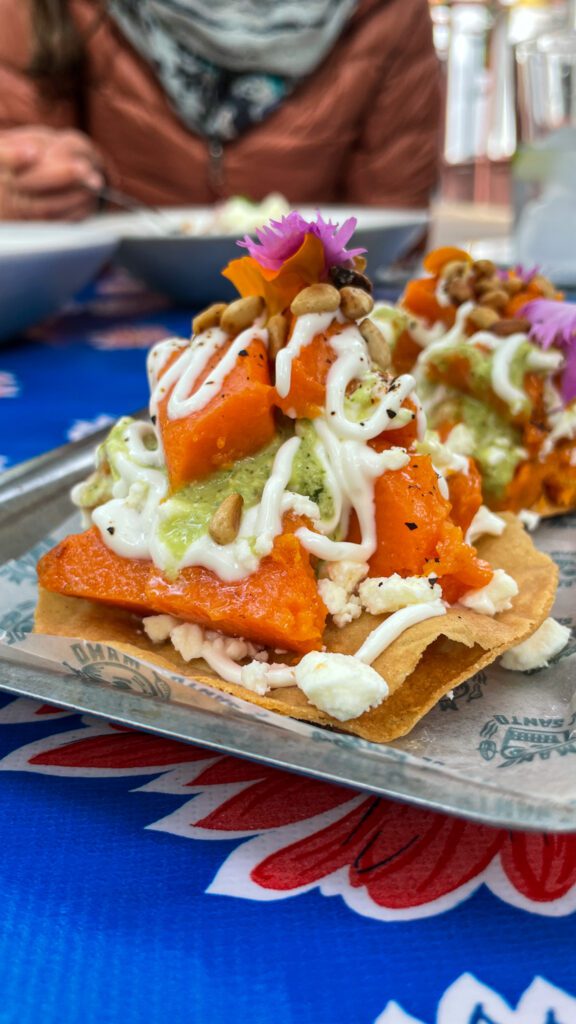
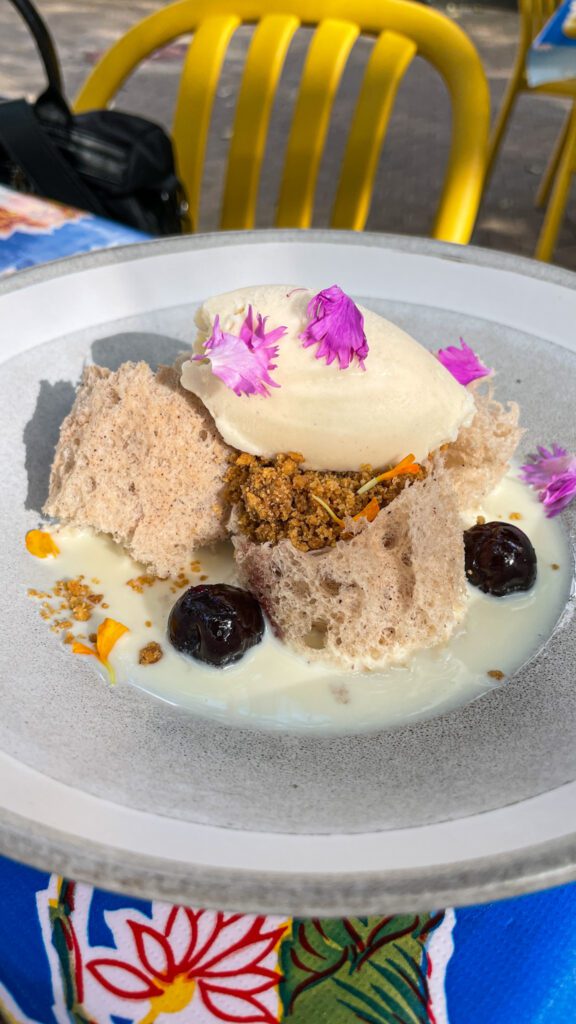
If you’re craving a drink, we also heard good things about El Viajero Sedentario and their cute little courtyard, though we didn’t make it there ourselves.
Day 2: Seville Cathedral, Plaza de España, and Foodie Adventures
On your second day, you’ll get multiple different views that are generally on every list of the best views in the entire city so that you can decide for yourself which one is king (or queen!).
The Seville Cathedral
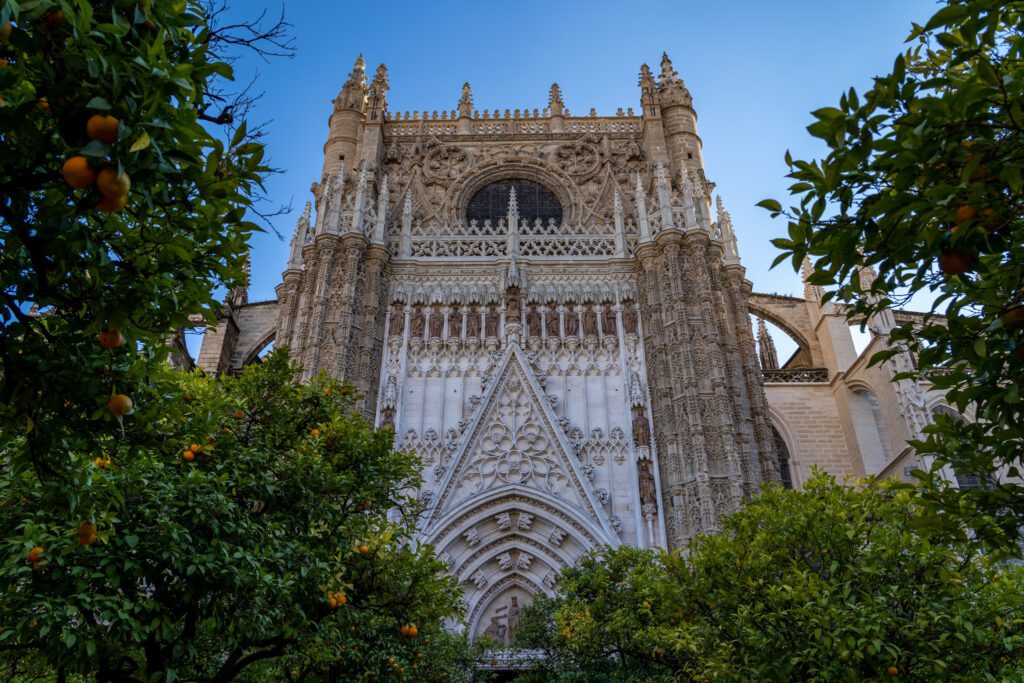
Look, we were nearing the end of our three months in Europe and we had seen A LOT of churches. To be honest, we strongly considered completely skipping the cathedral in Seville because, I mean, it’s just another church.
We were glad we didn’t for two reasons.
First, it’s the largest Gothic cathedral in the world. It’s an impressive structure, especially from the inside where you can see exactly how cavernous it is.
Second, the view from the Giralda – the bell tower that is built around the minaret of the former mosque that the cathedral is built on top of – is outstanding.
To get there, you won’t climb a neverending set of narrow steps, which seem to be the norm for old churches. Instead, they have a series of ramps that are much more pleasant to climb.
Do not miss the Giralda or the Patio de los Naranjos, which is the outdoor area that used to be a part of the mosque that has a couple of fountains (used to purify before praying in the Islamic faith) and, of course, those orange trees that you see all over the city.
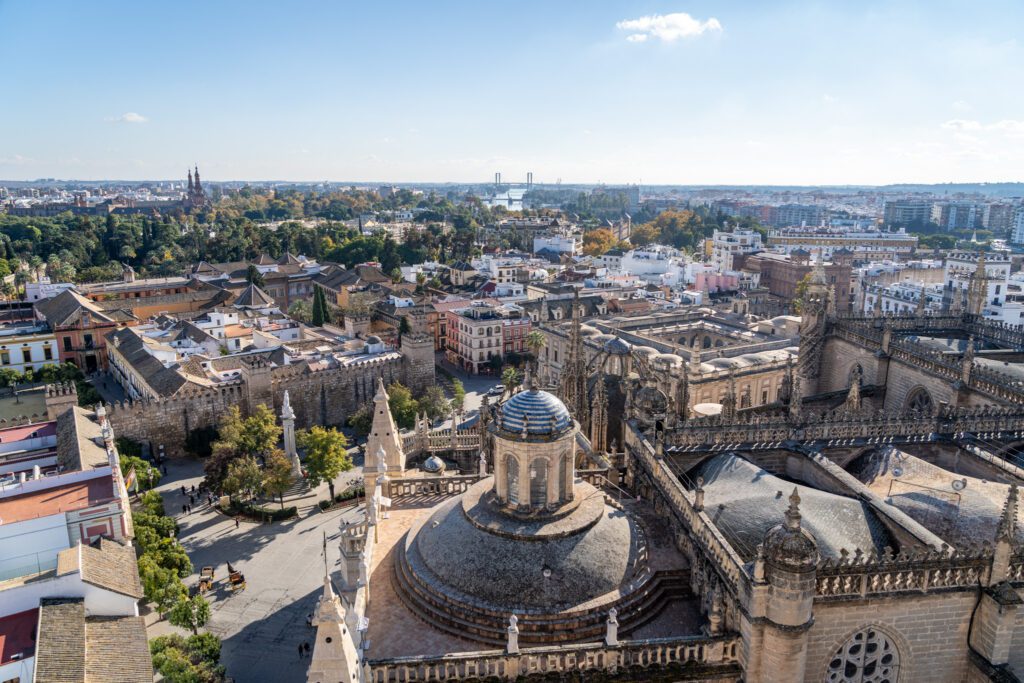
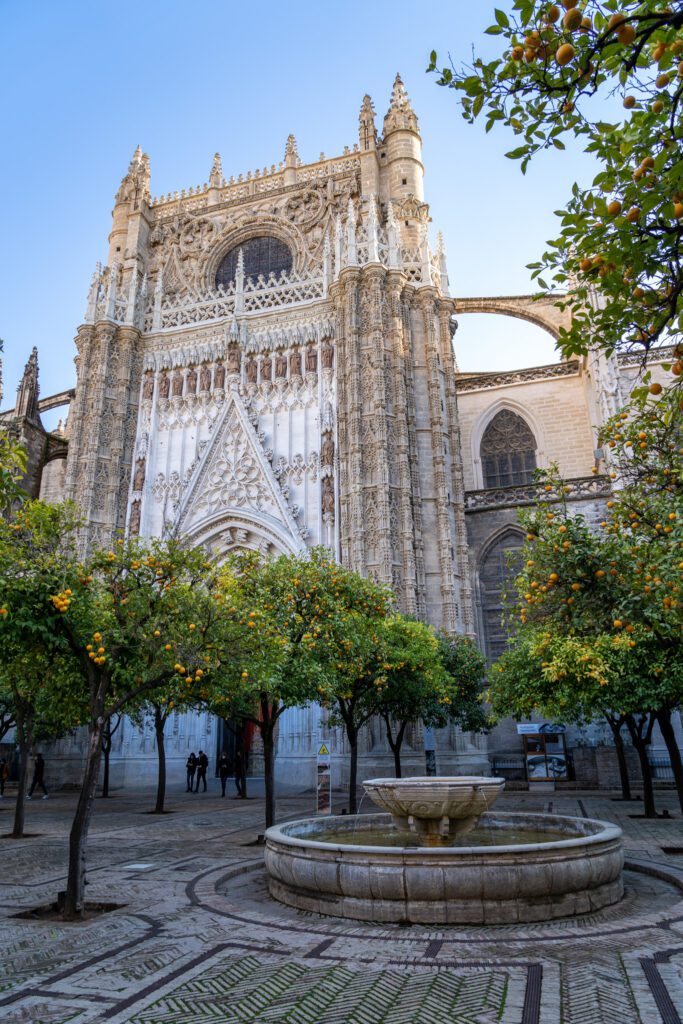
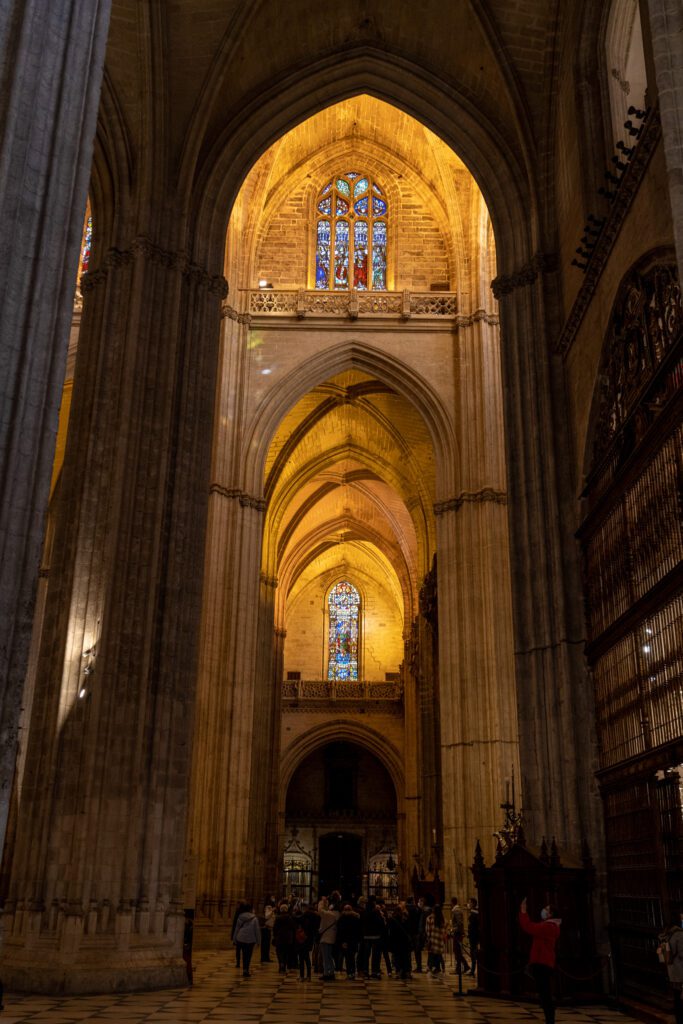
The cathedral is the other main sight in Sevilla, along with the Royal Alcázar, that gives you a good insight into the history of the city, since it was originally a mosque that was seized by the conquering Castillan king and transformed into a church over the course of a couple of centuries.
There’s a stark difference between the somewhat humble area where the mosque used to be, which is built of brick and only a couple of stories high, and the massive cathedral built next to it.
It’s almost like one has a primary function of being a place of worship, and one has a primary function of projecting power.
Which was a VERY common theme over the course of our travels in Spain, Italy, and Portugal.
Let’s Talk About Christopher Columbus
Oh, and Christopher Columbus’ tomb is inside the cathedral, and AT LEAST part of his body remains here after traveling around the world a couple of times posthumously.
It’s confirmed that the body in the tomb is Christopher Columbus after DNA tests were done recently, but it’s unconfirmed how much of his body remains in Cuba and the Dominican Republic, two other places he was buried at different times.
Of course, when we mention Christopher Columbus, we should also mention a few things, including the fact that he is basically famous for making a dumb mistake and thinking the Carribean was the Indies (and refusing to change his mind in the face of evidence saying otherwise).
He also committed ugly acts of genocide and enslavement, and is definitely not the hero we thought we were learning about when we learned that “Columbus sailed the ocean blue” in elementary school.
Oh yeah, on top of all that, he wasn’t even the first European to make it to the Americas!
The Vikings (who had issues of their own) beat him there by almost 500 years. Here’s a more digestible interview with a historian on the same topic.
Visiting the Cathedral
We don’t think a guided tour of the Cathedral is really necessary. If you do visit yourself, get the audio guide if you’re looking for more context behind the things you’re looking at. Buy tickets here.
Tickets cost 10 Euros per person, plus another 5 for the audioguide (share one to save money!). See their website for updated hours and costs, as they change fairly often.
Again, don’t miss climbing to the top of the bell tower! It’s worth the effort.
Plaza de España
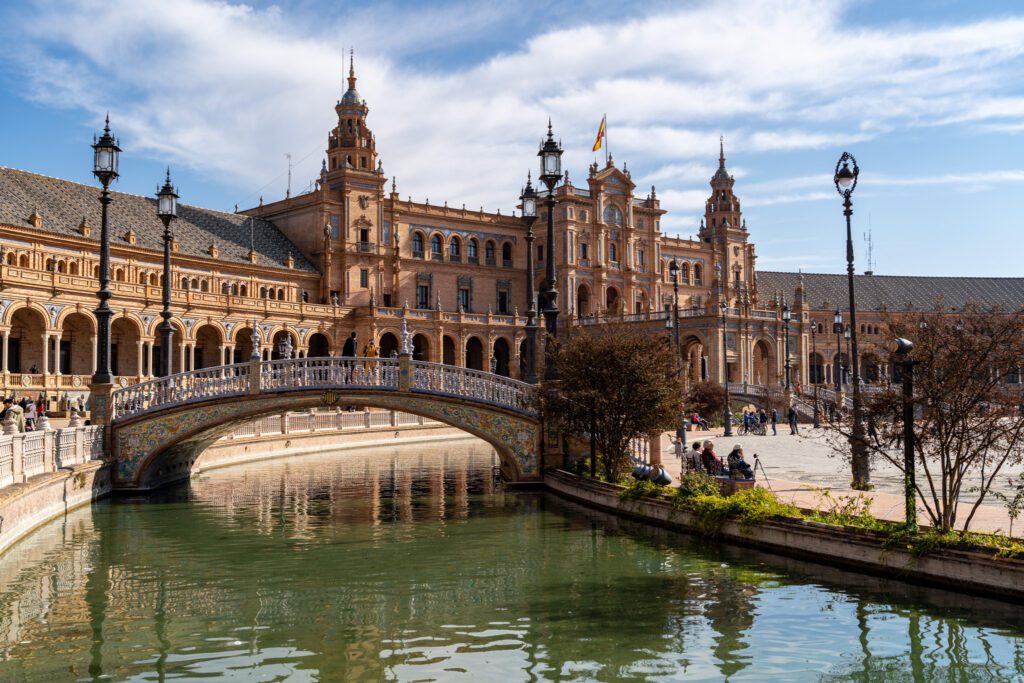
After the cathedral, head over to your second of three great views at Plaza de España.
This semi-circle shaped plaza was built for the Ibero-American Exposition of 1929, when Spain was looking to strengthen relationships with their former colonies in the Americas to stimulate more trade.
Unfortunately, it also happened to be the year that the stock market crashed. So it had, shall we say, room for improvement in terms of meeting their objectives.
The plaza is gorgeous though, and is well worth a visit. The two towers on either end loom over the half-circle, which has canals and four bridges representing the four kingdoms of Spain – Castille, Aragon, León, and Navarre.
Those four kingdoms are also represented on the crest in the middle of the Spanish flag, which I didn’t realize until noticing it here.
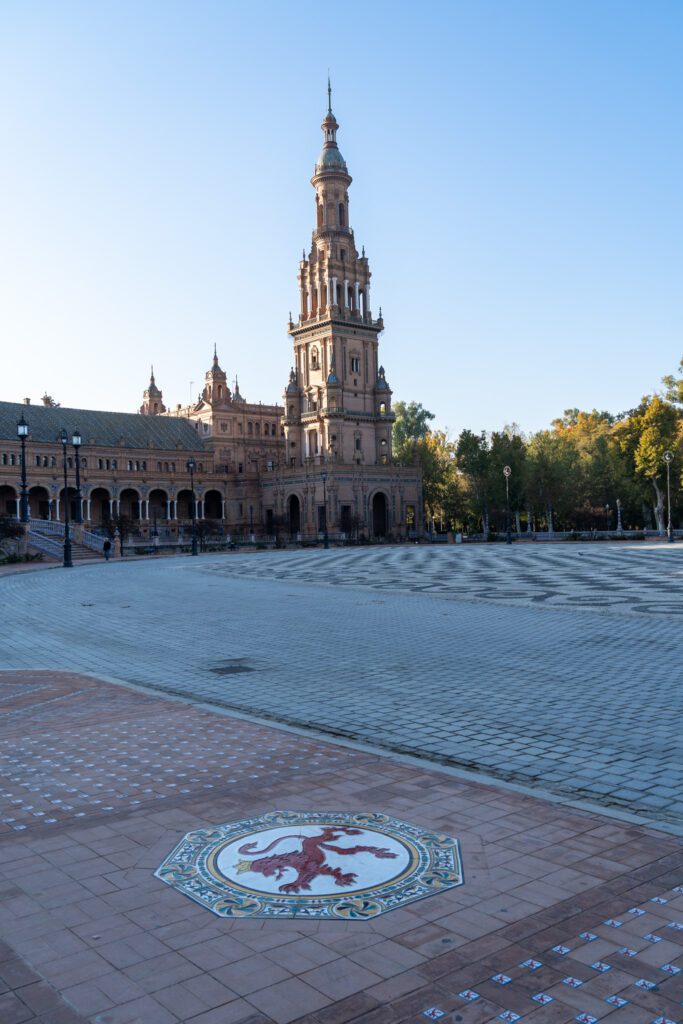
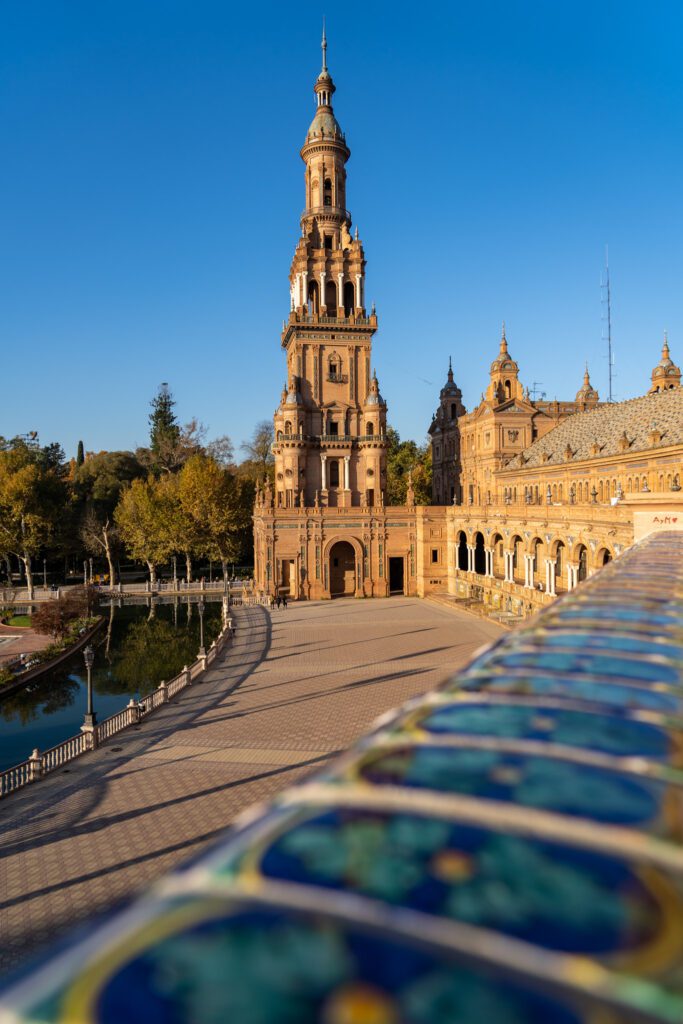
This is another place where famous movies have been filmed, and the most famous movie might also be the worst Star Wars movie ever made – Attack of the Clones (this might be a controversial take in 2021 post-Palpatine-revival, but I’m here for it).
Scenes from Naboo were shot in the corridors of the buildings around the plaza.
Make sure you head up to the second floor of the buildings next to the towers using the wide, open staircase. The views from the second floor out over the plaza are nice. See?
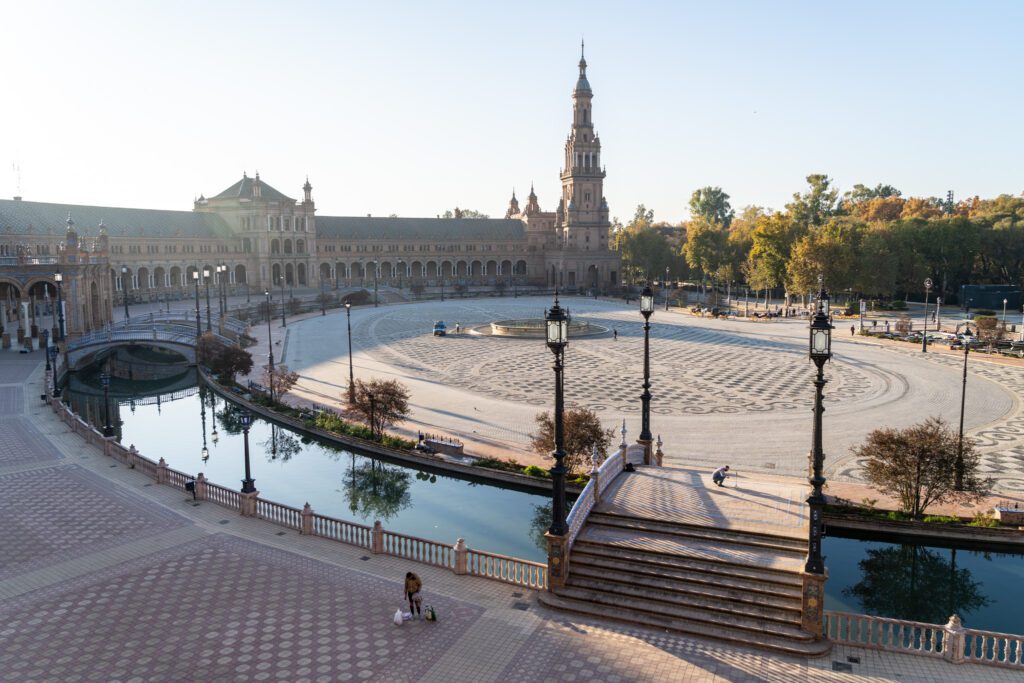
It’s also worth poking around the gardens, fountains, and all around loveliness of Parque de María Luisa, which is adjacent to the Plaza. Look for the gigantic geese (but don’t feed them!).
Las Setas de Sevilla
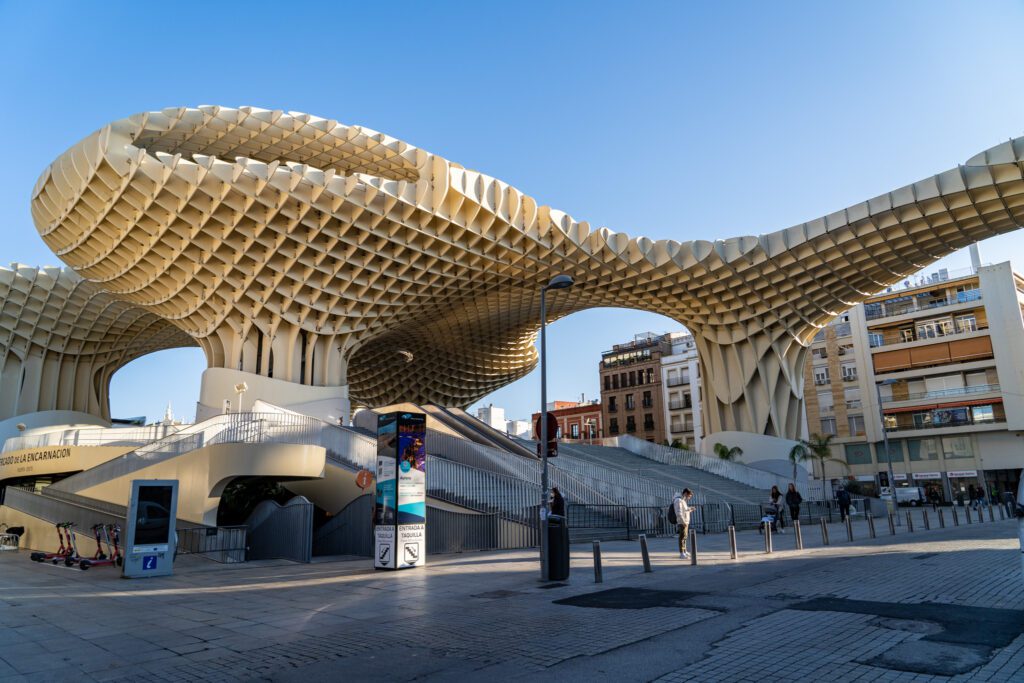
For the last of the nice views in Seville, head up to Las Setas de Sevilla, which is the giant mushroom-shaped wooden structure in the middle of the city.
They’re also known as the “Metropol Parasol,” and you’ll find them at La Encarnación square in the Centro neighborhood, about 10 minutes north of the Cathedral and Alcázar plaza.
The highlight here is the view from the top of the building, which will cost you 5 Euros to access.
It will take you about 15 minutes to walk along the path on the top, which has nice views in all directions, so you’ll need to decide if that’s worth it for you.
We did it, and were glad we did, but I can also see being disappointed by how little there is to do and see at the top.
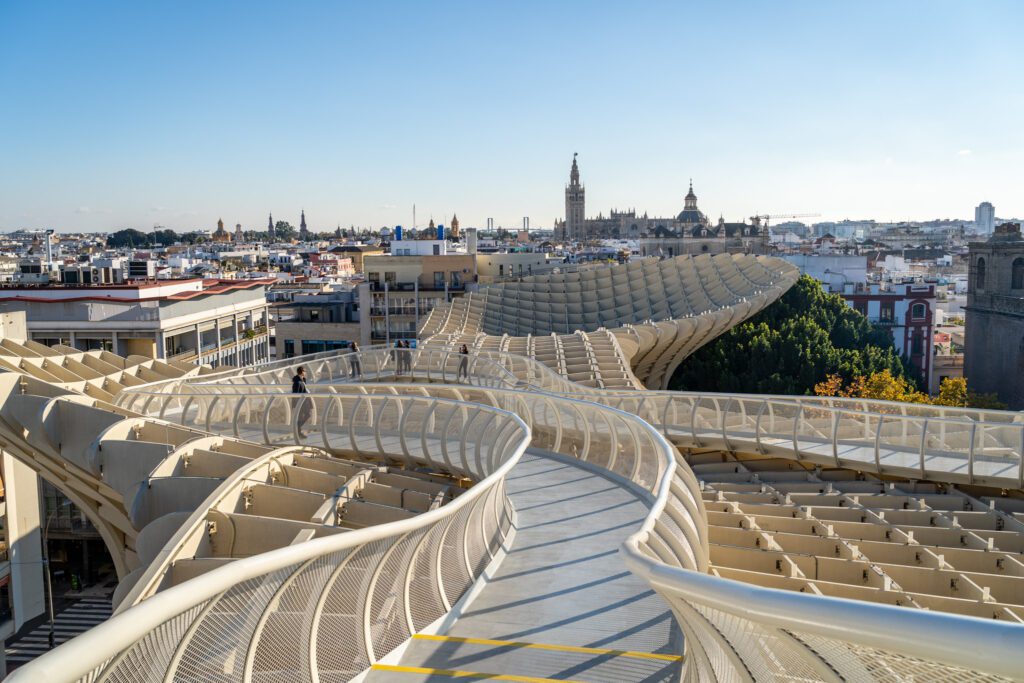
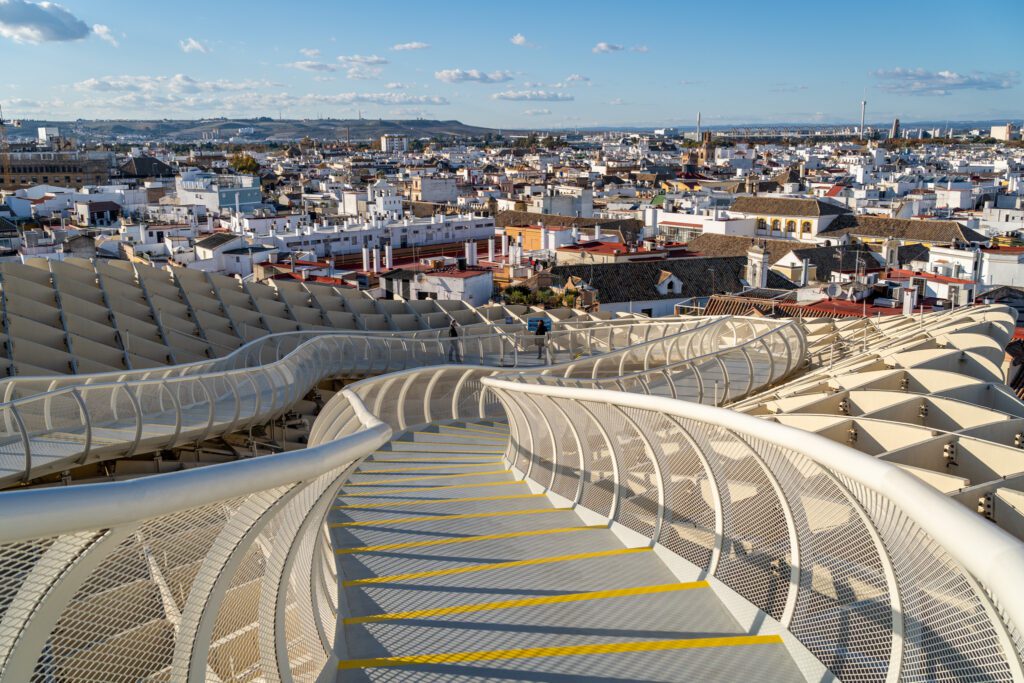
You can also come up here after the sun goes down, when there’s a light show that looks pretty fun. It costs extra, as does coming up around sunset.
On the bottom floor of the building, there’s some ancient Roman ruins, and on the ground floor there’s a nice market where you can get fresh produce, meat, and cheese (among other things).
Learn more and buy tickets in advance to skip the lines here.
Choose Your Own (Foodie) Adventure
Did anyone else LOVE those Goosebumps books where you could choose your own adventure as you went?
Did anyone else immediately return to the previous junction when you fell off a cliff or got eaten by a werewolf, or died in some other kind of gruesome way? Now that I think about it, those books are kind of dark for a kids series.
Anyway, the point is that we’re giving you a choice on your second night so that you can pick the perfect cap to your time in Seville.
The food in Seville is amazing, and we absolutely love getting the context and history behind the food culture in cities we’re visiting, particularly if it’s from a local.
We did a cooking class in Mexico City that we still talk about to this day, and we did a great paella class in Barcelona that we recommend as part of any Barcelona itinerary.
So, we’re going to give you three of your choices tonight that, naturally, all involve food.
We opted for a wine tasting class where we learned about Spanish wine and tasted a variety of them paired with Spanish cheeses, but we had our eyes on a cooking class and food tour as well. Without further adieu, here are your three choices.
Learn about Spanish wine (and cheese!): As we mentioned, this is the one we chose. We enjoyed learning all about Spanish wine, including the grape varietals and different wine regions in Spain, all from André, who is knowledgeable and passionate about all things related to Spanish wine (and so friendly and welcoming to people of all levels of knowledge about wine). He owns a small wine shop in Seville where he works exclusively with small producers. We loved it, and would highly recommend it for people who want to learn more about Spanish wine.
Go on a Food Tour with a Local Guide: Food tours are a great way to both connect with a local, who can give you a view of the city through their eyes, and to try some great food. We say great food, because usually these tours have done hours and hours of research (read: eaten a ton of churros) to find the exact right places to take you to. There are a bunch to choose from in Seville, but we’d opt for either this “Ugly Delicious” food tour (which shares a name with one of our favorite food shows of all time with David Chang) or this highly-rated Tapas Crawl.
Take A Cooking Class: We’ve done all sorts of cooking classes all over the world, and it’s one of our favorite things to do when we visit a new place. It has similar benefits to the food tour in terms of connecting with locals, and it also gives you something to add to your recipe arsenal to make back home, which will remind you of the amazing time you had at that great cooking class! We’d go for this cooking class with a real chef, where you’ll learn how to make some light tapas and Paella Valenciana (the O.G. of paella). Or, you could do this cooking class with the company at the Mercado Triana, but it takes place during the day so you’ll need to shift a few things around to make it happen.
Let Us Help You Plan Your Amazing Trip to Spain!
We’ve got plenty of other detailed guides for our favorite places in Spain – from Barcelona, to Madrid and Andalusia – that we wrote to help you plan an incredible trip.
P.S.: If the link isn’t there, it means we’re still working on it and the guide will be up shortly. It takes a lot of time and effort to put together these detailed guides! Bear with us.
- Two Weeks in Spain: How to Plan an Amazing 14 Day Spain Itinerary
- 4 Days in Barcelona: How to Plan the Perfect Barcelona Itinerary
- Where to Stay in Barcelona: A Complete Guide to 5 Great Areas
- Gluten Free Barcelona: A Complete Guide for Celiacs
- Exactly How to Take an Amazing Day Trip to Girona From Barcelona
- 2 Days in Madrid: A Complete Guide to Planning Your Madrid Itinerary
- Where to Stay in Madrid: A Complete Guide to 5 Great Areas
- Gluten Free Madrid: A Complete Guide for Celiacs (Restaurants + Bakeries)
- Taking A Day Trip to Toledo From Madrid: A Complete Guide
- 2 Days in Granada: A Complete Guide to the Best Things to Do in Granada
- 2 Days in Seville: A Complete Guide to Planning a Seville Itinerary
More Time in Seville?
If you find yourself with more time in Seville – 3 days in Seville or more – the first thing we’d recommend is taking a day trip to Córdoba, which was the capital of the Caliphate for centuries and has a ton of heritage related to the Muslim period in Spain, including the world-famous Mosque-Cathedral that is worth the visit alone.
It’s a 40 minute train ride on the high-speed train, so it’s an easy day trip.
If you go that route, make sure to read our guide to spending a day in Córdoba.
Other things to consider adding would be:
- One of the other food experiences (depending on what you chose for your second night).
- Catching a Flamenco Show (either at Casa de la Memoria or Museo del Baile Flamenco).
- Diving into the world of Sherry – a fortified wine that comes from southwestern Spain – with a day trip to Jerez and the surrounding area.
What to Do With One Day in Seville?
If you only have one day in Seville, here’s how we would spend it.
Do the Alcázar first in the morning, followed by a walk to Plaza de España.
Grab lunch at Triana Market and walk along the river before doing the Cathedral and Giralda.
Then end your day by choosing between one of the evening activities in the itinerary – one of the three foodie experiences, or Bar Comercio + dinner on Alameda de Hércules.
It’s going to be an action-packed day in Seville, but we think it’s doable.
When to Visit Seville
Seville’s high season is actually not in the summer, though the city is plenty popular then too. It’s busiest in the spring around Semana Santa and the Feria de Abril, two of the biggest events in Seville each year. Expect things to be fully booked far in advance and expensive if you’re visiting during the month of April.
The rest of spring is a very pleasant time to be in Seville – the temperatures are going to be more mild and bearable than the hot summer months, and the crowds aren’t quite what they are in April or July and August. Still, it’s going to be hot.
Expect temperatures in the 90’s during the day. Bring sunscreen and a reusable water bottle to avoid paying for numerous plastic water bottles – the tap water in Seville is totally safe to drink (and doesn’t taste bad at all).
Fall is similar to spring in terms of weather, with warm, dry days and fewer crowds than the springtime.
We were in Seville in November, and the winter weather had rolled in around the time we arrived. It’s a very pleasant place to be in the winter as long as you’re prepared for the cold.
In general, it was sunny and in the 50’s and 60’s (farenheit, because we’re American) during the day, and in the 40’s at night.
It starts out very chilly in the morning, and the heat builds over the course of the day, peaking at around 4:00 pm and resulting in a very pleasant early evening temperature.
Getting Around Seville
Seville is very, very walkable. The entire city is essentially flat, so you’ll never find yourself face-to-face with a gigantic hill like you might in San Francisco, our last real home.
From end to end in pretty much any direction, the city center can be walked across in about 20 minutes or less.
There’s an easy-to-use bus network that connects the city’s main train station with the city center. It costs 1.40 Euros per person, which you can pay to the driver when you board. The 32 is the bus we used, and it took us from the train station to the Setas (which are essentially in the middle of the city center) in about 12 minutes flat.
There’s also a single tram line, which we used to get out to the wine tasting class we did (which we loved, by the way – check it out here). You buy tickets from the machines on the tram platforms, and it costs the same as the bus (1.40 Euros each way).
Getting from the Seville Airport to the City Center
Getting from the Seville Airport (SVQ) to the city center is relatively straightforward.
The most affordable option is the Airport Bus, which picks up outside the main terminal and costs 4 Euros one way, or 6 Euros for a return ticket.
The bus comes every 15 minutes, and it will take between 30 and 40 minutes, depending on where in the city center you’re going. You can buy tickets from the driver on board the bus. More information here.
The other option is taking a taxi, which is faster at 15 minutes or so, but also significantly more expensive at around 25 Euros. Only take taxis from the main taxi stand at the terminal!
If you don’t want to worry about taking a taxi and you have a lot of luggage that will make the bus ride a nightmare, you can also book a private transfer from the airport to the city center, but it will be more expensive.
